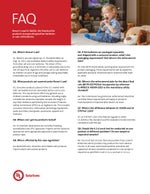What is Reese’s Law?
Reese’s Law was signed by U.S. President Biden on Aug. 16, 2022, and mandates federal safety requirements for button cell and coin batteries. The intent of this groundbreaking rule is to eliminate or adequately reduce the risk of injury from ingestion of button cell or coin batteries by children six years of age and younger during reasonably foreseeable use or misuse conditions.
|
What products are covered under Reese’s Law?
Consumer products placed in the U.S. market with both removable and non-removable button cell or coin batteries. The requirements affect any general use or children’s products except toys, using such batteries, including single-cell batteries where the diameter exceeds the height, or any other batteries identified by the CPSC as an ingestion risk. This includes consumer electronics, information technology equipment, audio and video, hard goods, accessories, apparel and footwear.
|
Where can I get my products tested?
UL Solutions laboratories in North America, Europe and Asia are accredited by the CPSC for 16 CFR 1263, the Safety Standard for Button Cell or Coin Batteries and Consumer Products Containing such Batteries, and can test your products to the requirements of UL 4200A. Projects will be routed to laboratories with appropriate approvals in place based on product type.
|
Who is affected by this new regulation?
Manufacturers, importers and retailers who produce, import and/or sell covered products.
|
If the batteries are packaged separately and shipped with a consumer product, what’s the packaging requirement? And when is the enforcement date?
Individually packaged button/coin cell batteries (sold individually or packaged separately with a product using these batteries) must comply with 16 CFR 1700.15 poison prevention standards for child resistant packaging. In addition, warning label requirements for batteries packaged separately product packaging are defined by 16 CFR 1263.4 applicable for products imported or manufactured after Sept. 21, 2024.
|
When is the enforcement date for the direct final rule (88 FR 65274) that incorporates by reference to ANSI/UL 4200A-2023 as the mandatory safety standard?
Reese’s Law required CPSC to promulgate a rule for button cell or coin batteries and consumer products that contain such batteries. The CPSC has published the direct final rule 88 FR 65274 that incorporates by reference ANSI/UL 4200A-2023 as the mandatory safety standard. The requirements are codified at 16 CFR part 1263 and apply to consumer products that contain button cell or coin batteries manufactured or imported on or after March 19, 2024 (enforcement discretion).
|
What is the difference between UL 4200A and 16 CFR Part 1263?
16 CFR Part 1263 is the federal regulation, while UL 4200A is the standard used for evaluation to demonstrate compliance with the law.
|
Should the 6.3.4 crush test be conducted on one position or different positions? On one sample or separated samples?
You must test at more than one position if you cannot determine which position may produce the most adverse results. In all cases, each tested position should be self-supported. All tests should be conducted on one sample in sequence as specified in sub-cl. 6.2.1 and sub-cl. 6.3.1.1
|
Should the drop test be conducted on fragile products?
Yes. The drop test, like other abuse tests in UL 4200A, aims at testing the battery compartment to see if the button cells become accessible or liberated after being dropped and fragile products are not exempt. Breakage of fragile components will not be considered if this breakage does not affect compliance with the standard.
|
What are the packaging requirements for online products delivered to consumers in a shipping carton?
a) - If the online purchase product does not have its own retail packaging but is only directly contained in a shipping carton, companies should follow the “Markings” requirements in section 7, for both packaging and product, of the UL 4200A standard.
b) - If the retail packaging is inside the shipping carton, it must be labeled according to the standard. The product shall comply with all requirements when imported to U.S. rather than after import. The laboratory could not evaluate its shipping carton unless the shipping carton is the retail packaging when it shipped from the factory.
|
If the warning in 7C.1 cannot be affixed on the product display panel due to space constraints, is it acceptable to have the warning in 7C.2 printed on the backside of the battery compartment cover (provided that the size of the cover is only large enough to house this warning icon)?
Sub-cl. 7C.2 applies when space on the product is limited and the warning text as specified in 7C.1 cannot fit the dimensions.
A warning printed on the backside of the battery compartment cover will not meet sub-cl. 7C.2 requirements because it will not be visible for the consumer unless the battery compartment cover is removed.
Regardless of whether the battery is replaceable or not, it is emphasized that the product display panel must be visible. This emphasizes the need for warning information to be placed in a prominent location, specifically where it can be immediately seen before replacement.
|
Is it acceptable to use electronic versions of instructions for the content required by the standard?
Staff concludes that to have the intended effect of providing warnings and safety information to consumers, the warning language must be included physically along with the product.
|
For laptop computers, if button batteries or coin cell batteries can only be accessed through the removal of multiple enclosures or panels using a tool, which enclosures or panels must display the warning label?
Reese’s Law requires that warning labels be placed directly on a consumer product in a manner that is visible to the consumer upon installation or replacement of the battery. Even for products with non-replaceable batteries, Reese’s Law requires warning labels to be placed in a manner that is visible upon access to the battery compartment.
|
How can UL Solutions help me prepare for compliance?
UL Solutions can help you understand the certification and requirements of Reese’s Law. Our deep knowledge and understanding of 16 CFR part 1263 and UL 4200A make UL Solutions a trusted testing and certification company for importers and manufacturers. We have over a century of expertise in compliance and safety testing. Our technical experts, who cover more than 150 countries, sit on international committees that develop industry standards and updates. Ultimately, we can help you reduce risk and position your products for success with retailers.
|


